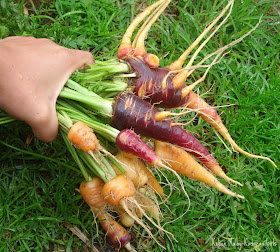I always thought turnip was one of the easiest vegetables to grow for a novice to begin with. Unfortunately after having my own experience at growing turnip, not that easy if you don't have enough water or not much rain at our small garden. The seeds germinate easily and grow fast.
I thought that turnip form globe root very fast almost like radish pace. But ours seems not to want forming globe root. Our turnips just do nothing but grow lush leaves. Then after long anticipation, most of the time our turnips seems to be more fond of growing long woody root rather than globe root.
So when I spy some of those turnip roots look like the size of S size chicken eggs after waiting for more than 3 months, I am most determined to harvest them quickly before it becomes woody. Is it normal for turnip to form roots after 3 months or it should be much much much earlier? This is 'snowball' variety.
The first time that I known that in this world a vegetable called "turnip" exist was when I was studying in Japan. I was teaching Malaysia language part-time at Japan and one of my student said that it is kabu season now (kabu is turnip in Japanese). So of course my students will want to know what turnip is called in Malaysia language. It made me sweat a little, after a very detailed description from my beloved students I knew that it is turnip. However, until now I still don't know whether we have any specific name for turnip in Bahasa Malaysia (does anyone know?). I tried to translate it in google translator but resulted as "orang bodoh" meaning idiot.
Harvested those tiny turnips and I don't have any ideas to prepare it.Nigel Slater came to the rescue again with his simple ' A little Dish of sweet turnip" recipe from his book Tender.I like simple dishes because with food that comes fresh from the garden we don't have to worry about the taste that much. Just enjoy as much of its original flavour to really enjoy the food that we grow. Saying that, I have to be honest that I still avoid eating raw vegetables (Still in learning process to get used of eating raw vegetables).
I think it takes less than 30 minutes to prepare this simple dish to enjoy with roast bird which we did. Quoting Nigel " The contrast between the sweet outer shell and slightly bitter turnip is astonishing with roast game birds".
Drop tiny turnips into lightly salted boiling water and cook for 10 minutes or so until tender.Drain.
Melt a thick slice of butter in a shallow pan and add the turnips and a spoonful of sugar.
Cook over medium heat, shaking the pan from time to time, until the little orbs are glossy and sweet.
I decided to pop in uncooked pink radish together too. I am still avoiding raw radish.
Not sure how the end process of the dish suppose to look like because there were no photos.
However, it was a nice dish.
Selamat Berpuasa.


















































